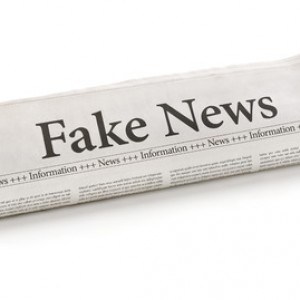Seeing through fake news

The term ‘yellow journalism’ started in the late 1800’s when two of the largest New York City newspaper publishers, Joseph Pulitzer and William Randolph Hearst, respectively began sensationalizing and creating fake news leading up to the Spanish-American war. Both publishers were infamous in their ability to twist the facts, leave out details and regularly make up news – all to sell more newspapers.
Today, fed by social media, search engine optimization, bots, ego or one-sided agendas, we as a global society are faced with overwhelming and increasing numbers of so-called fake news – real looking false stories or blog posts written solely for sensational impact and deception. Driven by technology that can spread fake news around the globe at unparalleled speed, hundreds of thousands and even millions of people are consuming fake news either intentionally or unintentionally.
No topic is immune from fake news, but in the final months of the last U.S. presidential election, fake news reached staggering new heights. According to a news analysis from BuzzFeedNEWS, “In the final three months of the US presidential campaign, the top-performing fake election news stories on Facebook generated more engagement than the top stories from major news outlets such as the New York Times, Washington Post, Huffington Post, NBC News, and others ….”
The BuzzFeedNEWS analysis went on to say that the “20 top-performing false election stories … generated 8,711,000 shares, reactions, and comments on Facebook.” Compared to 7,367,000 of “the 20 best-performing election stories from 19 major news websites.”
With so much fake news available, the begging question is how to see through it all? Here are three ways to get to the truth compiled by several sources:
- Look at the quotes in a story. According to NPR, “Most publications have multiple sources in each story who are professionals and have expertise in the fields they talk about. If it’s a serious or controversial issue, there are more likely to be quotes — and lots of them. Look for professors or other academics who can speak to the research they’ve done. And if they are talking about research, look up those studies.”
- Find the original reports. Geek.com says, “Fake news doesn’t always mean false news. The really bold fake news sites simply make things up out of whole cloth or take uncorroborated social media posts as truth, but more often you’ll see a story that actually happened but is being told to you in a very specific, misguided way. That’s why you need to drill down to the original source of the story.”
- Search to see if other news outlets are reporting it. Huffington Post says, “If a story looks suspicious or claims to reveal major news, search to see if other news outlets are also reporting the story. A single article from a suspicious source making a grand claim should be viewed with heavy skepticism. If no reliable news outlets are also reporting the story, then it’s very likely fake.”
It is clear media outlets such as Facebook and Twitter understand the power they wield in the distribution of fake news. Facebook in particular indicated they plan to thin out fake news or provide ways for their community to tell the difference between fake and real news.
In a Facebook statement on fake news, Mark Zuckerberg, said, “We don’t want any hoaxes on Facebook. Our goal is to show people the content they will find most meaningful, and people want accurate news. We have already launched work enabling our community to flag hoaxes and fake news, and there is more we can do here. We have made progress, and we will continue to work on this to improve further.”
Though fake news has always been a part of society, it today seems to be used at an ever increasing pace. Following these three steps along with others that are available, people can see through fake news. Additionally, you can use these sources to find out if stories or topics are fake or fact: Politifact, Snopes, and Fact Check.
Of course, writers, bloggers, and journalists could all decide to write only accurate stories based on fact and using accurate sources and analysis making it easier for us all to consume ‘real news.’
